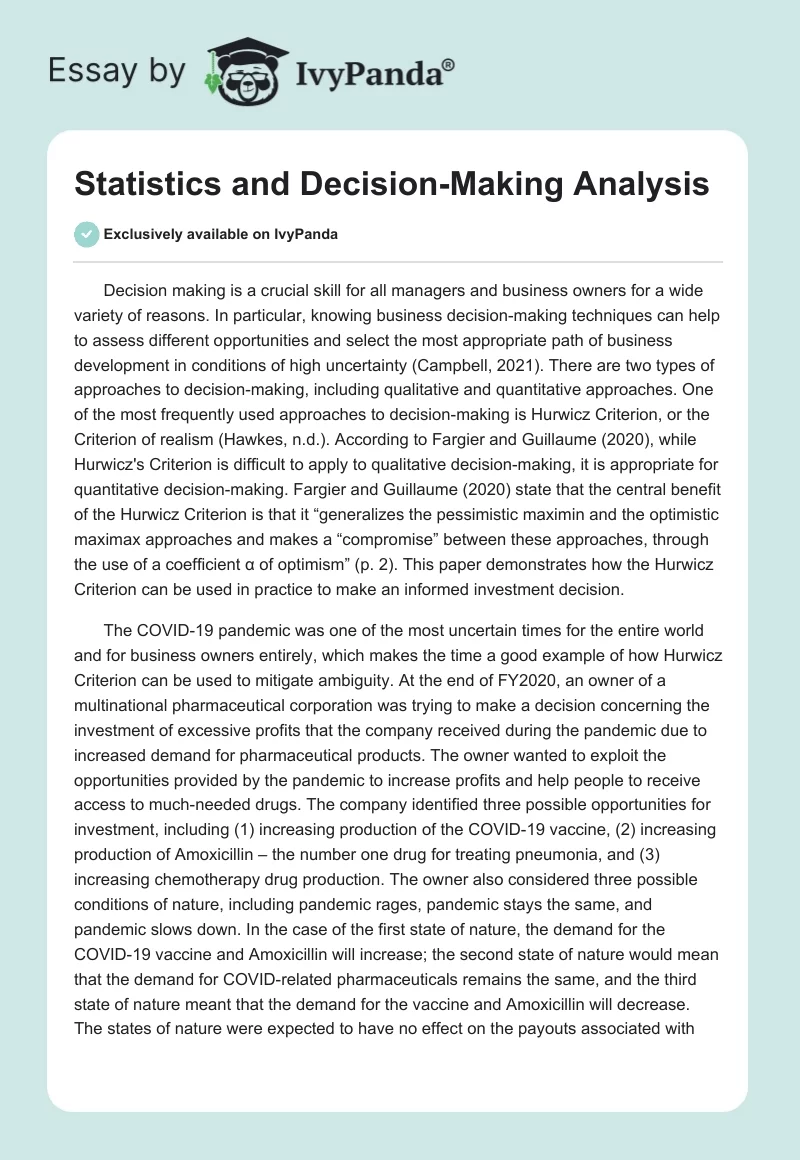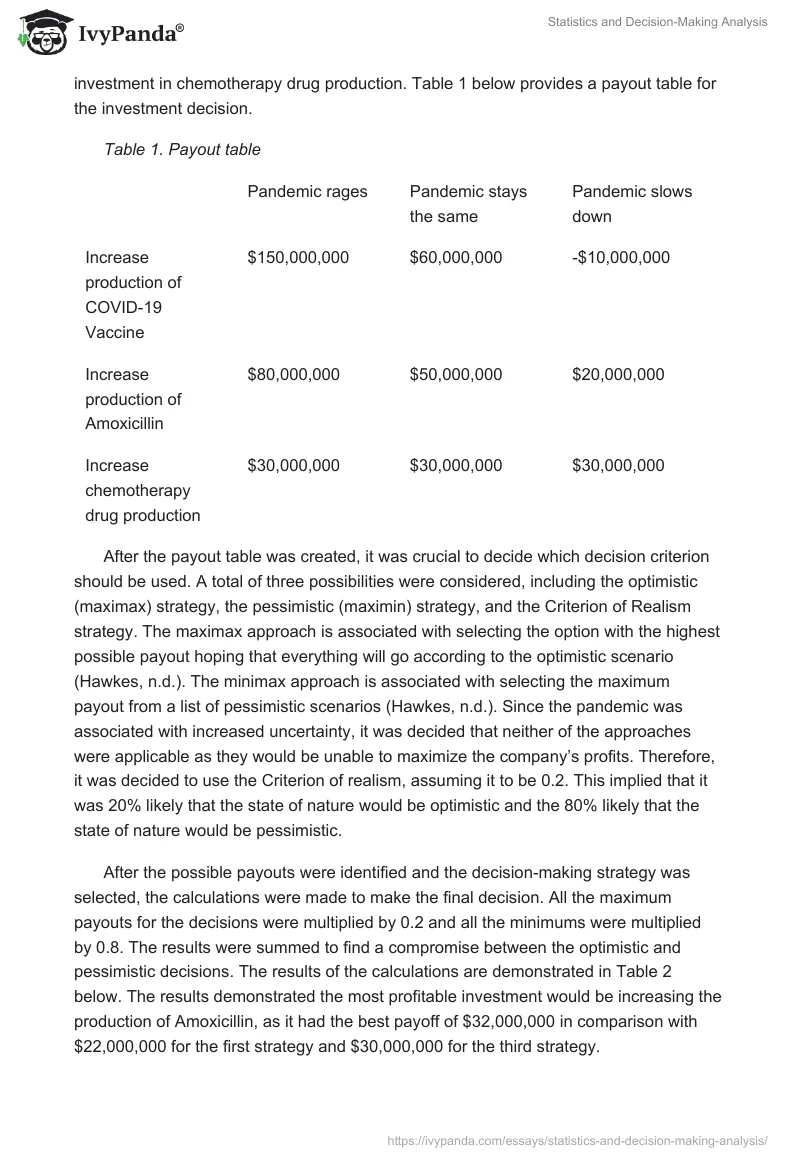Decision making is a crucial skill for all managers and business owners for a wide variety of reasons. In particular, knowing business decision-making techniques can help to assess different opportunities and select the most appropriate path of business development in conditions of high uncertainty (Campbell, 2021). There are two types of approaches to decision-making, including qualitative and quantitative approaches. One of the most frequently used approaches to decision-making is Hurwicz Criterion, or the Criterion of realism (Hawkes, n.d.). According to Fargier and Guillaume (2020), while Hurwicz’s Criterion is difficult to apply to qualitative decision-making, it is appropriate for quantitative decision-making. Fargier and Guillaume (2020) state that the central benefit of the Hurwicz Criterion is that it “generalizes the pessimistic maximin and the optimistic maximax approaches and makes a “compromise” between these approaches, through the use of a coefficient α of optimism” (p. 2). This paper demonstrates how the Hurwicz Criterion can be used in practice to make an informed investment decision.
The COVID-19 pandemic was one of the most uncertain times for the entire world and for business owners entirely, which makes the time a good example of how Hurwicz Criterion can be used to mitigate ambiguity. At the end of FY2020, an owner of a multinational pharmaceutical corporation was trying to make a decision concerning the investment of excessive profits that the company received during the pandemic due to increased demand for pharmaceutical products. The owner wanted to exploit the opportunities provided by the pandemic to increase profits and help people to receive access to much-needed drugs. The company identified three possible opportunities for investment, including (1) increasing production of the COVID-19 vaccine, (2) increasing production of Amoxicillin – the number one drug for treating pneumonia, and (3) increasing chemotherapy drug production. The owner also considered three possible conditions of nature, including pandemic rages, pandemic stays the same, and pandemic slows down. In the case of the first state of nature, the demand for the COVID-19 vaccine and Amoxicillin will increase; the second state of nature would mean that the demand for COVID-related pharmaceuticals remains the same, and the third state of nature meant that the demand for the vaccine and Amoxicillin will decrease. The states of nature were expected to have no effect on the payouts associated with investment in chemotherapy drug production. Table 1 below provides a payout table for the investment decision.
Table 1. Payout table
After the payout table was created, it was crucial to decide which decision criterion should be used. A total of three possibilities were considered, including the optimistic (maximax) strategy, the pessimistic (maximin) strategy, and the Criterion of Realism strategy. The maximax approach is associated with selecting the option with the highest possible payout hoping that everything will go according to the optimistic scenario (Hawkes, n.d.). The minimax approach is associated with selecting the maximum payout from a list of pessimistic scenarios (Hawkes, n.d.). Since the pandemic was associated with increased uncertainty, it was decided that neither of the approaches were applicable as they would be unable to maximize the company’s profits. Therefore, it was decided to use the Criterion of realism, assuming it to be 0.2. This implied that it was 20% likely that the state of nature would be optimistic and the 80% likely that the state of nature would be pessimistic.
After the possible payouts were identified and the decision-making strategy was selected, the calculations were made to make the final decision. All the maximum payouts for the decisions were multiplied by 0.2 and all the minimums were multiplied by 0.8. The results were summed to find a compromise between the optimistic and pessimistic decisions. The results of the calculations are demonstrated in Table 2 below. The results demonstrated the most profitable investment would be increasing the production of Amoxicillin, as it had the best payoff of $32,000,000 in comparison with $22,000,000 for the first strategy and $30,000,000 for the third strategy.
Table 2. Calculations of decision payouts
The example provided in this paper demonstrates how Hurwicz Criterion can help to make decision in the conditions of extreme uncertainty. It was decided to invest in increasing the production of Amoxicillin. If the optimistic strategy was used, the decision-maker would select to increase the production of the COVID-19 vaccine. At the same time, if the pessimistic strategy was selected, the decision-maker would have selected to invest in chemotherapy drugs. Thus, the selected decision-making strategy helped to find a compromise between the optimistic and pessimistic approaches to account for the probability of events.
References
Campbell, L. (2021). Strong decision-making skills will give you a leg up in the job search — here’s how to show them off. Business Insider. Web.
Fargier, H., & Guillaume, R. (2020). Sequential decision making under ordinal uncertainty: a qualitative alternative to the Hurwicz criterion. International Journal of Approximate Reasoning, 116, 1-18.
Hawkes, J. (n.d.). Discovering Statistics and Data (e-book). Hawkes.


